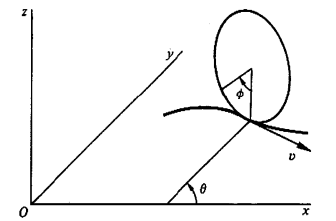The Goldstein book has the following question (1.11):
Consider a uniform thin disk that rolls without slipping on a horizontal plane. A horizontal force is applied to the center of the disk and in a direction parallel to the plane of the disk.
(a) Derive Lagrange’s equations and find the generalized force.
(b) Discuss the motion if the force is not applied parallel to the plane of the disk.
In the previous pages, they showed a similar scenario with the following illustration:
In this case, the coordinates $x$ and $y$ are the coordinates of the center of the disk, an angle of rotation $\phi$ about the axis of the disk, and an angle $\theta$ between the axis of the disk and $x$ axis. If I understood right, the disk just rolls in one direction, so I can resume the question to a movement in one direction, just about one axis, like what was done here.
But I saw here an explanation using all the coordinates from the book. But this does unnecessary to me, and one special result it's specifically strange. Solving the Lagrange equation for $\theta$ they found these results:
$$a^2\ddot{\theta}+\frac{3\cos\theta}{\sin^3\theta}\dot{x}^2=0$$
I think that this has something wrong, because if the center of mass stays the movement in the same direction by all the time, and this is the situation that I understood that is the question, so $\theta$ is constant, but then $\ddot{\theta}=0$, so $\dot{x}=0$. And this isn't a result that sounds physically correct to me.
So, this last equation is really wrong, or it's I that understood something wrong?

